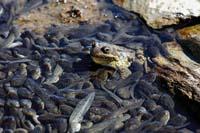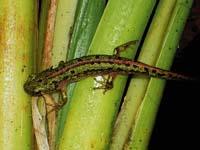Local example of global decline
2006/05/01 Gosá Oteiza, Alberto - ARANZADI Zientzi Elkarteko biologoa | Rubio Pilarte, Xabier - ARANZADI Zientzi Elkarteko biologoa Iturria: Elhuyar aldizkaria
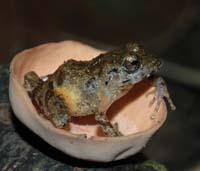
Attention should be paid to the skin to determine the animal's ability to respond adequately to both good and harmful environmental conditions. This is because the skin will suffer overheating --abrupt or, in climatic processes, of long duration-; the skin will allow to detect the composition of water in times of increase or larva; and powerful antibiotics will occur on the surface that protect this humid tissue, which can be an unbeatable opportunity for pathogens. The skin will also be affected by any changes that humans have caused in the environment. The bark will first collect pollution, acid rain and changes in soil, leaf litter, forest structure or levels of luminosity.
Immediately before the changes a complex set of physiological, anatomical or behavioral responses will be launched. The animals will try to escape the environment that has changed, but due to its small size and limited capacity of movement, it will be complicated and become seasonal. Or, to prevent water loss from dehydration, they will only circulate at night and use underground tanks. Or they will adorn it with flashy colors to chase away predators. Finally, millions of years of evolution will allow them to survive in extreme ecosystems, from the boreal forest, where there are frogs capable of freezing blood in hibernation, to the desert, where some types of toads spend years under the sand.
In fact, in this journey of millions of years amphibians have reached an enormous genetic diversity, and that is the treasure they offer us. Several experts highlight this treasure the arrabios of the tropics: only some species accumulate greater genetic diversity than whole vertebrate groups. If the argument is taken to the extreme, it can be said that for biodiversity the loss of one of those harbors is more serious than the disappearance of all ducks in the northern hemisphere. Therefore, the conservation of amphibians is of vital importance, especially considering the current global decline.

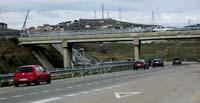
Global decline
The future of amphibians worldwide is not prosperous but very dark. Global decline is a reality seen in America, Australia, Europe... And before obtaining obvious evidence of decay, habitat destruction was the main cause of amphibian disappearance. Other causes of widespread decline must be added to habitat loss: new diseases, pollution of large areas such as acid rain, or increased class B ultraviolet rays associated with the ozone layer. All these factors --and their interactions - are causing dramatic effects on amphibian species and populations.
In Euskal Herria, however, the influence of these other factors has not yet been demonstrated, despite the fact that in certain populations there have been episodes of local diseases and that there are few wells in which amphibians are dead in reproductive times. On the contrary, around the Pyrenees of Huesca the disappearance of populations affected by the 'red leg' disease has been confirmed. This type of pest can appear at any time in the Basque Country, so it is important to keep track when animals approach wetlands for reproduction.
However, what has been observed so far suggests that the decline of amphibian populations in our territory is due to the destruction of the original habitats. Beliefs, as explained below, have already been confirmed in some populations.
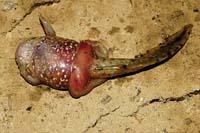
Consequences of the transformation of the environment
Human activity of a few thousand years has radically transformed the natural environment we have shared with amphibians since birth. In Euskal Herria, on the Atlantic side, the forest has become agricultural land. The landscape consists of rotating grasslands, scrubland and remains of ancient forests that are currently only small trees. Forest plantations of foreign conifers and eucalyptus predominate. The oak, beech and marojales have been preserved only in the mountain area of the humid slope and in the transition zone. On the Mediterranean side, dry crops and vineyards stand out.
However, can we say that these transformations make the amphibian community poorer today? It is difficult to answer this question. You know what the populations were like thousands of years ago. However, the scarce fossils found and the biogeographic analysis of current amphibians indicate that --arrived in glacial times through the Pyrenees' journeys - there was a community of amphibians like the one we have long ago.
Nor can we answer the following question. That is, are amphibians currently more abundant or less? They are believed to have decreased. Although in some well-preserved areas it is known that the current and former abundance may be similar, it is generally observed that abundance has decreased. And it is no wonder to think that, because, like never before, the XIX. Since the industrialization of the 20th century, the natural environment has suffered in a very short time numerous attacks.
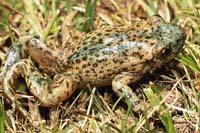
Habitat as amphibians
In the Atlantic side, different environments very similar to the continental ones are interspersed, so many of the amphibians that emerged here have lived comfortably in our country. The bushes, orchards surrounded by shrubs, pastures and fields, riverside vegetation, water courses, hamlets, water deposits, wells, neighborhood roads and trails constituted a mosaic of habitats that facilitated communication between population centers.
The risk lies in the fragmentation of this habitat, either through infrastructure, or through extensive crops that match the landscape. This transformation produces a barrier effect with insurmountable limits for amphibians. Note that the number of species coincides with habitat diversity. The more different ecosystems, the less competition between species will be, as different places of residence will explode.
Therefore, when designing the management of the Atlantic landscape, new concepts of habitat fragmentation and connectivity between populations, for example, can be decisive. The current management of the territory has meant the need for intervention on the populations, which has often been the only effective measure of protection. It is known that the number of wetlands, the distance between them and the density of the roads condition the diversity of amphibians among others.
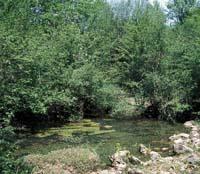
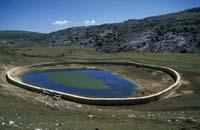
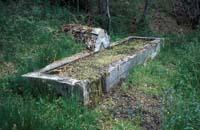
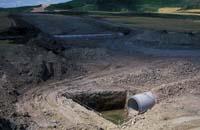
The reduction and simplification of habitats as a consequence of fragmentation, the construction of infrastructure in the center, very dangerous for amphibians, make that gradually isolate populations and decrease the number of individuals. And that is what, unfortunately, is happening on the Atlantic side of Euskal Herria. The regional networks between Bilbao and Baiona are being complicated until they end the separation between the peoples. The Basque city?
Significant and unrecoverable faunal gaps are occurring. Fragmentation not only prevents the existence of continuous populations, but also prevents new migratory colonizations. In short, it is about avoiding a biogeographic flow that has allowed the distribution of current species. Consequently, as they are increasingly reduced, without relations between them and separated by increasing distances, the only future left to the populations is their disappearance. Final and, in some cases, immediate.
Mediterranean slope
The spatial structure of southern Euskal Herria is completely different. Also amphibian species, originated in the Mediterranean and in the peninsula itself. On the contrary, they are of vital importance to local biodiversity. In fact, on many occasions, our Mediterranean area is the northern boundary of the geographical distribution of these amphibians.
In the Ebro valley, in an extensive plain as dry as temperate, the climate forces populations to live around wetlands. Many of them have been built by man. The distribution pattern of amphibians in the area is corresponding to the specific presence, that is, they are intimately linked to the breeding places of amphibians, being the migratory routes between wells. In this case, the original Mediterranean vegetation plays a fundamental role in the communication between the populations, the native scrub. The strong impact of the roads can be considered secondary here, limiting only to the humid areas and points that cross the migratory routes.
For these terrestrial populations cereal is the main obstacle. Extensive agricultural areas become barriers. For amphibians they are a desert: they barely have a lair, the sun hits full and, in addition, they are full of phytosanitary products that pollute the waters and eliminate invertebrates. Amphibians find the last land settlements in the few remains of scrub and hedges between remaining plots. They have no more.
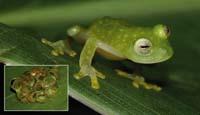
Although it may seem untrue, some populations have developed behaviours and tricks to survive in the most disadvantaged areas of the south, against seasonality and changing weather conditions such as drought. They reduce the aquatic phase of the larva to complete metamorphosis before the wetland completely dries. They can also carry out a second reproductive period of autumn or winter taking advantage of the rains of those times.
In the humid soils located on the Atlantic slope it is much more difficult to form ponds. It is a matter of capacity. On the one hand, it sends relief and steep slopes favor surface runoff; on the other hand, population density is enormous and human populations have settled in those places suitable for amphibians. The disappearance of wetlands, landfills, fields and plantations, constructions and infrastructures have been accompanied by man. Old lakes and swamps have been replaced by seasonal rafts and rafts. In those who have often remained, water quality and water level are not the most suitable for amphibians and, in addition, changes in the environment are constant. Therefore, wetlands cannot reach maturity.
The knot narrows. Altered habitats, polluted and without future, amphibians are condemned to live in painful conditions. Trapped in an increasingly complex road network, cut off exchange and communication between populations, they are locked. In the end, despite being amphibians, it drowns.
